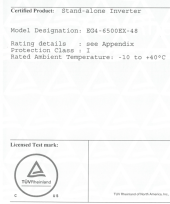I am grateful for your responses and time.
I was less than clear about the situation. There will two separate systems at the same house. Currently, one is a standard residential 240 split phase service panel that feeds my house. The solar system is intended to be an off-grid source of power during grid outages that will feed a non-grid connected mini-split heat-pump and enable connection of 12 AWG extension cables to run a freezer, refrigerator, and a few lights in case the grid goes down.
An EG4 6548 EX inverter and EG4 5.1kV battery will be delivered 2022-06-01. I was going to connect my main service panel's AC into the EG4 6548 EX via a 125A sub-panel for AC into the inverter. From what I understand, to avoid more than one N-G bond in the house's electric system the inverter's N-G bond screw would have to be removed in order to enable grounding the inverter via the AC input fed from the main service panel.
Unfortunately, there appears to be no feasible code-compliant/permittable way to connect an off-grid inverter that is not UL Listed to a sub-panel connected to a main service panel. In order to have a legal installation in my area, a UL listed off-grid inverter must be installed by a licensed electrician and the installation must meet National Electric and International Construction Codes. Currently, the EG4 6548 EX inverter is not UL Listed. In my area, without UL listing, an inverter will not be permitted to be connected to the grid via a sub-panel.
Upon the realization that my original plan was not feasible, my thought was to run an Equipment Grounding Conductor (EGC) from the ground of the inverter's AC output panel back to the main service panel. To avoid multiple N-G bond points, the inverter's AC output panel would not bond neutral to ground but would instead be bonded back at the main service panel via the EGC run from the ground terminal in the sub-panel.
To make sure I have only one N-G in the system, I was going to remove the N-G bond screw in the inverter as if AC input power from the main service was supplied. I am still not sure if bonding the inverter's AC output panel to the service main ground is allowed by code.
Diagram 2 above is almost exactly what I was thinking with the exception that the diagram shows the N-G bond screw is still connected in the inverter.
Please advise on two questions:
1) if the inverter output AC panel is connected via EGC back to the main service panel's ground bar, should the N-G bond screw in the inverter be removed?
2) Does connecting the EGC to the main panel violate NEC code?
I apologize to the pros on the forum if my thoughts are naive, I am grateful for thoughts on the matter.




